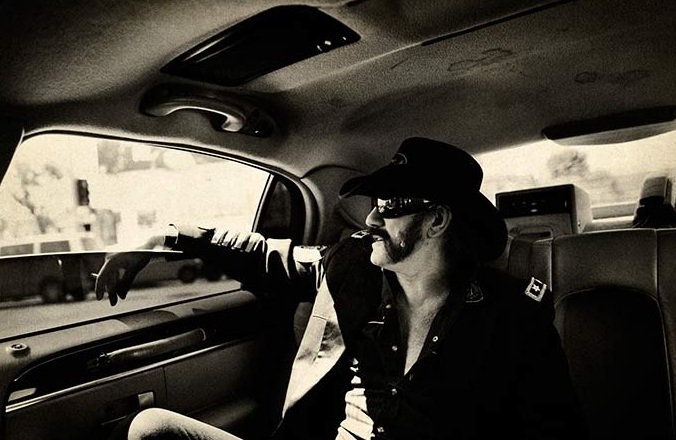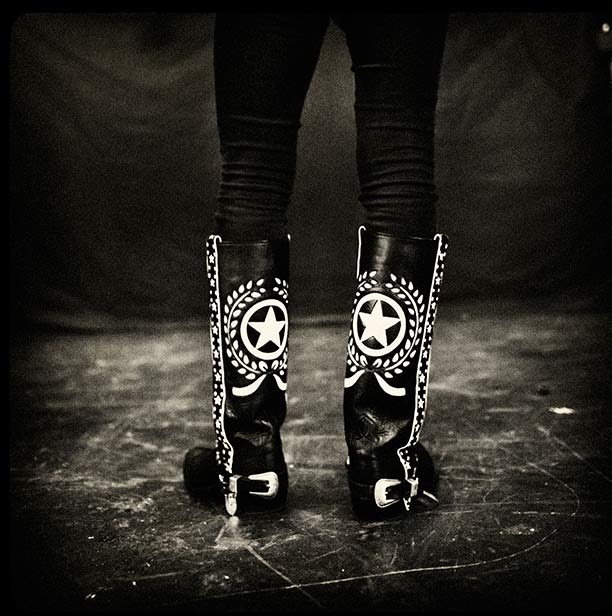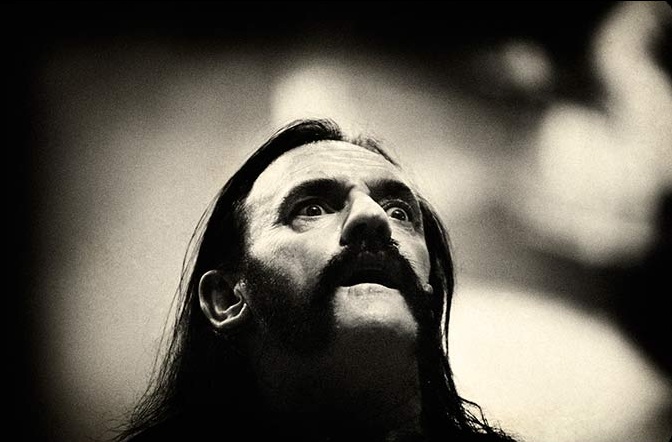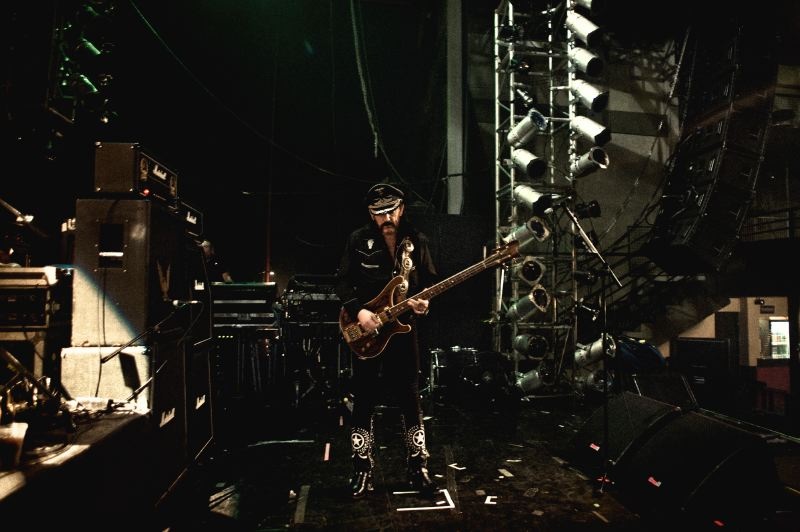 GRC-Mg (c/San Lucas 9, Madrid) presenta «Röadkill – Motörhead» primera exposición individual en Madrid de Pep Bonet, uno de los fotógrafos españoles más respetados en la escena documental internacional. Durante la inauguración, el 20 de diciembre a las 20:00 (la clausura será el 2 de febrero), se presentará el libro “Röadkill”, flamante creación de Pep Bonet que estará presente para firmar ejemplares y contarnos su experiencia con “Lemmy” Ian Fraser Kilmister, mítico líder de la banda de Rock and Roll más ruidosa del mundo desde su creación en 1975 (AQUÍ tenéis su interesantísima entrevista con HRB, por cierto).
GRC-Mg (c/San Lucas 9, Madrid) presenta «Röadkill – Motörhead» primera exposición individual en Madrid de Pep Bonet, uno de los fotógrafos españoles más respetados en la escena documental internacional. Durante la inauguración, el 20 de diciembre a las 20:00 (la clausura será el 2 de febrero), se presentará el libro “Röadkill”, flamante creación de Pep Bonet que estará presente para firmar ejemplares y contarnos su experiencia con “Lemmy” Ian Fraser Kilmister, mítico líder de la banda de Rock and Roll más ruidosa del mundo desde su creación en 1975 (AQUÍ tenéis su interesantísima entrevista con HRB, por cierto).
 RÖADKILL , EL SONIDO DEL INFIERNO
RÖADKILL , EL SONIDO DEL INFIERNO
Mötorhead es el Rock and Roll más potente y duradero del siglo XX. Algunos lo llaman Heavy, Speed o Thrash pero en el siglo XXI sigue siendo Rock & Roll, nada más. Porque sólo la buena música a un volumen brutal es capaz de sacar la bestia que todos llevamos dentro. Porque hay cosas que no cambian. Motörhead es una de ellas.
RöadKill es una hoja de ruta maldita, una autopista fotográfica, un mapa mudo de las venas del grupo más consecuente de la historia del rock. “Trueno, luego existo” parece decir, en cada estrofa, su líder eterno: Lemmy Kilmister, la garganta más castigada del escenario en los últimos 35 años, lo más parecido al Ángel Caído de nuestras mejores pesadillas. Porque hay que estar muy dormido o simplemente muerto en sus directos, para no sentir una corriente de música eléctrica que entra por el espinazo y sube por dentro hasta reventarnos la cabeza. “We are Motorhead and we play Rock & Roll”, así empiezan todos sus conciertos…una declaración de intenciones descarada, sincera, atronadora.
Eso es esta exposición-libro del fotógrafo Pep Bonet, Rock & Roll escrito en el aire. El tesoro inédito de la época más reciente de esta banda británica, un documento para la historia del Rock arrancado a mordiscos noche a noche, milla a milla, foto a foto, verso a verso. Una misión infernal, extrema, que le obligó a ganarse la confianza de la banda mítica con los colmillos retorcidos, hartos de fotógrafos-groupies, celosos de su intimidad. Un periplo que le mantuvo más despierto que los que nunca duermen, más vivo que los que nunca mueren y algunas noches, más muerto que los huesos de Lucifer.
La historia de esta aventura envenenada comienza en 2008, cuando Pep Bonet se dejó los puños aporreando la puerta de la redacción de la revista Rolling Stone, hasta convencer a su director para que creyera en su trabajo. El que resiste gana y por fin consigue un trabajo sin condiciones previas. Podía elegir el tema que quisiera. Su decisión fue clara, el instinto no engaña: quiero seguir a los Mötorhead. Y es que en ocasiones, tener las cosas tan claras puede llevarle a uno a donde quiera.
 Pep sabía adónde quería llegar, al corazón del Snaggletooth, al cuartel general de su banda favorita. Así comenzó poco a poco a trabajar junto a la banda, a distancia prudencial, sin la obsesión de querer saberlo todo. Un día, Lemmy le echó una mirada y levantó su Jack Daniel´s en señal de respeto. Cuando quiso darse cuenta, Pep ya formaba parte de esa familia. Echando también un buen trago de birra fría antes de colocar la cámara, el fotógrafo disfrutaba del momento. Sin pensar nunca qué ocurrirá mañana. Así aprendió a manejarse entre los focos apagados, esperando la noche, cuando las sombras le contaban más cosas que las luces.
Pep sabía adónde quería llegar, al corazón del Snaggletooth, al cuartel general de su banda favorita. Así comenzó poco a poco a trabajar junto a la banda, a distancia prudencial, sin la obsesión de querer saberlo todo. Un día, Lemmy le echó una mirada y levantó su Jack Daniel´s en señal de respeto. Cuando quiso darse cuenta, Pep ya formaba parte de esa familia. Echando también un buen trago de birra fría antes de colocar la cámara, el fotógrafo disfrutaba del momento. Sin pensar nunca qué ocurrirá mañana. Así aprendió a manejarse entre los focos apagados, esperando la noche, cuando las sombras le contaban más cosas que las luces.
El proyecto ya estaba en marcha: Röadkill. Bajo el objetivo de su cámara: gira europea 2008, Sudamérica 2009, Los Ángeles 2010 documentando la grabación del hasta ahora último disco The Wörld is Yours y los festivales europeos 2010. Nacía de pronto una colaboración sincera y ya imborrable entre fotógrafo y su banda de Rock & Roll. Esta es una historia grabada a fuego por la que muchos hubieran dado media vida por vivir, con ellos, en la carretera.
Disfrutad malditos. El Röadkill de Mötorhead nos enseña en imágenes cómo suena el infierno.
Texto de Ignacio Jarillo
Sobre Pep Bonet
Pep Bonet (Mallorca, 1974) es un fotógrafo que ha ganado muchos premios internacionales habiendo viajado extensivamente capturando profundos momentos que representan la desigualdad del mundo en que vivimos. Sus proyectos de larga duración están enfocados a problemas en África, como su más conocido proyecto “Fe en caos”, un ensayo fotográfico sobre las secuelas de la guerra en Sierra Leone. Su trabajo en progreso de Pep sobre HIV alrededor del mundo lo ha llevado a la publicación de varios libros de fotografías y exhibiciones en diferentes puntos del planeta.
Su trabajo más reciente incluye el reportaje de larga duración a la banda de rock and roll Motörhead. Pep dedicó tres años (2008-2010) a recorrer carreteras con Lemmy Kilmister, legendario cantante de la banda, y creando un documento visual excepcional sobre esas horas en ruta. También a partir de este trabajo creó “Lemmy´s Box”, una caja de colección hecha a mano de la cual existen solo 25 ejemplares que contienen 10 copias cada uno.
El trabajo de Pep ha sido reconocido con muchos premios de la industria fotográfica. En 2002 fue escogido para World Press Photo Joop Swart Masterclass con su trabajo “Fe en caos”. El mismo año fue nominado “uno de los 30 para ser vistos” por Photo District News. Pep ganó el Kodak Young Photographer del año 2003 en el festival “Visa pour l’image”, y el Lunchetta Foundation en Trieste lo nominó el mejor fotógrafo de prensa del año 2004.
Recibió el premio W. Eugene Smith Humanistic Grant in Photography en 2005 y en 2007 ganó el segundo premio en el World Press Photo en la categoría Deporte con su trabajo sobre la liga de football de los amputados de Sierra Leone. En 2009 Pep ganó un segundo World Press Award por su trabajo “Identidad Forzada”, retratando las vidas de los transexuales de Honduras.
Su lista de publicaciones incluye “Generacion Perdida” (2010), “Remarkable South Africans”(2009), «Photobolsillo», de la colección de La Fabrica, “One Goal” (2007) y “Somalia: The Invisible Trace” (2007), «Quadern de Bitacola», un libro de texto escrito por Carles Domenec y “POSITHIV+” (2005), “Watching in Silence” (2011), “17 milagroso” (2009), “217A; a NOOR book” (2008).
Pep trabaja en proyectos personales incluyendo video y en encargos para clientes y ONGs. Frecuentemente ofrece lecturas sobre fotografía y talleres. Vive en Mallorca.
VERSIÓN EN INGLÉS
GRC-Mg presents «Röadkill – Motörhead» first solo exhibition in Madrid by Pep Bonet, one of the most respected Spanish photographers in the worldwide documentary scene.
Durante la inauguración se presentará el libro “Röadkill”, flamante creación de Pep Bonet que estará presente para firmar ejemplares y contarnos su experiencia con “Lemmy” Ian Fraser Kilmister mítico líder de la banda de Rock and Roll más ruidosa del mundo desde su creación en 1975.
During the vernissage we will present “Röadkill” his brand new book creation. Pep Bonet will be at the opening to sign books and to tell us his experience on the road with “Lemmy” Ian Fraser Kilmister mythic lead of the most noisy Rock and Roll band since 1975 until today: Motörhead.
RÖADKILL , the sound from hell
ONE DAY, I got an e-mail, which is typically how work-related things in the modern world tend to start.
It was from Motorhead’s manager, Todd Singerman, who had in turn received word from the band’s US publicist about a request. From Rolling Stone. Sort of.
What they wanted was to run a portfolio of work from Malljorca-based photojournalist, Pep Bonet. Anything he wanted to shoot. Anything he’d already shot. They wanted it. Pep is one of those guys who’s adrenaline junkiedom juxtaposes with the feral need to show the rest of us worlds we don’t know exist on our planet and in our continents. He’s tended to concentrate his efforts in Africa, particularly Sierra Leone and Sudan. His work is raw like skin freshly-scraped on concrete yet beautiful like a mediterranean sunset, and Pep works the beauty and the beast well, finding life and warmth within environments teaming with hardship.
I say this, because when Pep got the request from Rolling Stone, his response was a gracious ‘yes, thank you and I want the portfolio to be of Motorhead.’
At the time it probably seemed a little left-field to everyone, but really, it wasn’t.
It made perfect sense.
Warriors and madman, charged and visceral, beauty and the beast, chiefs and their tribes, a bouquet of explosive emotions.
Motorhead inspire all of those feelings, and Pep (by virtue of his work to this point) has lived them, seen them and captured them with other tribes.
There was no guarantee that Rolling Stone would run the portfolio, and they weren’t going to front him any expenses, but Pep was prepared to invest if we’d give him the access. It was, he explained, a labour of love.
I immediately insisted that we give him every access he needed, and I was swiftly supported by Todd. I offered to meet him at the start of the band’s tour in the UK and introduce him to the ‘greater tribe’ of the band’s roadcrew, as well as be on hand for a couple of days to explain to Lemmy, Phil and Mikkey why Pep was there.
When I picked Pep up from Gatwick for the drive up to the Wolverhampton Civic Hall on Monday November 3rd, 2008, I was struck not only by his ‘Spanish hippy-metal’ appearance and incredibly warm demeanour, but by his eyes…and I don’t give a damn how weird that might look, it’s the truth! They revealed clearly that he was a man who genuinely loved what he did, a man who had a warmth, flexibility and openness about him that I had rarely encountered in journalism. He was easy-going in a way I hadn’t expected, yet passionate in explaining what he wanted to do. It was obvious that Pep was incapable of bullshitting, and that further strengthened my resolve to fight for him and his efforts where (and if) necessary.
As I introduced him to the crew in Wolverhampton, to Eddie and Emma, Tim and Roger, Dan, Adam and Stefan and anyone and everyone I knew he’d run into, I noticed how instantly people warmed to him. Which is not something to be sniffed at. Bands on tour, especially road-dog legends, have their own ways and means, their own methods, their own camps their own smells and their own routines. Outsiders, interlopers, journalists and ESPECIALLY photographers are not necessarily welcome, ESPECIALLY when they want to live with you for a month or three, and ESPCIALLY on the first day of a UK tour when the lighting desk decided to try and take a massive shit mid-show.
I’d spoken to Lemmy about this a few weeks prior to our arrival, and by way of introduction, Pep had brought over some of his books for Lemm (and the band) to see. I took Pep in to meet Lemm, and a firm handshake later, Lemm was chatting with him about some of the photographs, about crazed one-legged men manacled to walls and beating their heads off the stones, of soccer teams who’s players were amputees, of dead soldiers amidst war-torn dust country. Lemm got it. And besides, I think he liked Pep. It’s that simple with Lemm; if he sniffs a bastard then it’s ‘bye-bye’ but if he likes the cut of your jib then it’s ‘hello and let’s see how this goes.’
Mikkey and Phil were both instantly onboard, Mikkey in particular very clearly digesting what Pep was going to be doing, whilst Phil was (I think) delighted to entertain a ‘newbie’ and generally have a breath of fresh air on the road, not to mention a fresh photographic perspective.
I explained to Pep many times that it would take time, that he’d have to work his way ‘on to’ the tour so-to-speak, that riding on the bus would be a drawn-out process earned by persistence, patience and trust. He said he’d hire a car and follow the tour until such a time as he managed to work his way in. And so it was that armed with an AA roadmap of Great Britain and an itinerary, I left Pep at Heathrow a few days later to begin trailing and tagging and hanging and shooting Motörhead, their crew, their fans, their equipment, their everything, on the road.
Pep ended up driving the length and bredth of Britain. And a portion of Belgium. Perhaps even some of Germany, I’m not sure off the top of my head.
I suspect he was sleep-deprived but I never asked him, I mean, what’s the point of asking an obviously sleep-deprived man if he’s sleep deprived?!
But he was always beaming with energy at the work he was getting done, and I never heard negatives about him being here, there and everywhere. It was going well.
There was a brief moment in December 2008 when the band were wired and tired, Pep was busy and buzzing and wanting to ride with them through Germany and they were just too fried. I explained to him that it might be best to knock this leg on the head, to pack up and recharge for the New Year. Which he did. And which became April in South America, where Pep got super-close to Motörhead, traveled with Motorhead, ate with Motörhead, slept with Motörhead and got fully engaged with (and by) the Motörhead juggernaut. Whether hanging out with Phil Campbell and his short-leg, short-arse trick at godforsaken hours in clubs of ill-repute or in the sanctuary of Lemm’s dressing room discussing war, The Beatles or comedy, Pep found himself ‘in’ on the old-schooler’s ‘in’ track.
When I first saw a selection of Pep’s work with Motörhead, I realized that every instinct I’d felt had been vindicated. He’d captured the energy, the intensity, the stature and the reverence of the band. He’d found them at their loudest and quietest, funniest and most serious. He’d done what great photographers do and he’d framed Motörhead, this vitally important, iconic steam train of hard rock’n’roll history, this gloriously timeless bastard of a band, as the legends they are. It was the sort of uniquely photo-journalistic-cum-artist portfolio I’d always felt the band deserved, yet always feared they’d never get…
…which is why this book is here.
To present to you the unique and timeless legend Motörhead.
And thanks to Pep Bonet, you will feel like the elephant in the room, like the fly on the wall…like the ultimate voyeur.
Because there are people who have known Motörhead for decades who have never seen them as intimately as this.
Consider yourselves privileged.
Steffan Chirazi
About Pep Bonet
Pep Bonet (Mallorca, 1974) is an award-winning photographer who has traveled extensively capturing profound moments that represent the unbalanced world in which we live. His longer-term projects focus on African issues, with his most well known project being “Faith in Chaos”, a photo essay on the aftermath of the war in Sierra Leone. Pep’s ongoing work around the globe on HIV/Aids has led to several photography books and many exhibitions worldwide.
His more recent work includes a long-term reportage on the rock ‘n roll band Motörhead. Pep spent three years (2008-2010) on the road with Lemmy Kilmister, the legendary singer of the band and created an exceptional visual document of the many hours spent on the road with
Motörhead. He also created «Lemmy’s box», a hand made collector’s box existing of 25 exemplars showcasing 10 prints.
Pep’s work has been recognized with many industry awards. It started in 2002 when he was selected for the World Press Photo Joop Swart Masterclass with his work “Faith in Chaos”. That same year he was nominated “one of the top 30 to watch” by Photo District News. Pep won the Kodak Young Photographer of the Year in 2003 at the festival Visa pour l`image, and the Luchetta Foundation in Trieste nominated him the best press photographer of the year in 2004.
He was a recipient of the W. Eugene Smith Humanistic Grant in Photography in 2005 and in 2007 won the second prize in the World Press Photo contest in the Sports category for his work on the amputees’ football league in Sierra Leone. In 2009 Pep won a second World Press Photo Award for his work “Forced Identity”, portraying the lives of transsexuals in Honduras.
His list of publications include “Generacion Perdida” (2010), “Remarkable South Africans”(2009), «Photobolsillo», a new Photobolsillo from La Fabrica with a collection of Spanish photographers, “One Goal” (2007) and “Somalia: The Invisible Trace” (2007), «Quadern de Bitacola», a text book written by Carles Domenec and POSITHIV+ (2005), Watching in Silence (2011), 17 milagroso (2009), 217A; a NOOR book (2008).
Pep works on personal projects, including video, and on assignments for clients and NGO’s. He frequently lectures on photography and conducts workshops. Pep lives in Mallorca.


